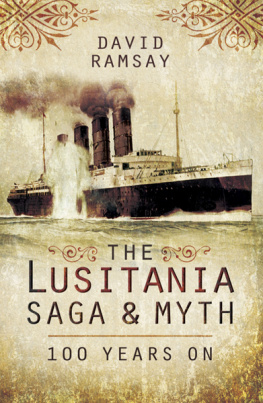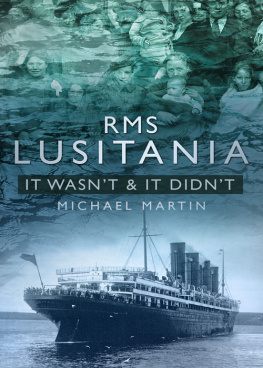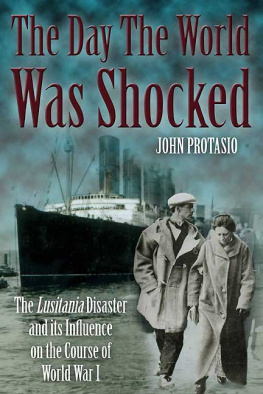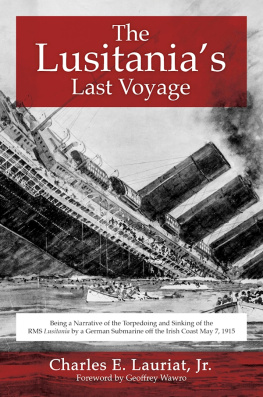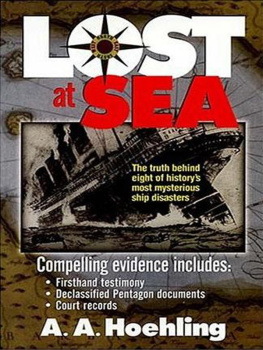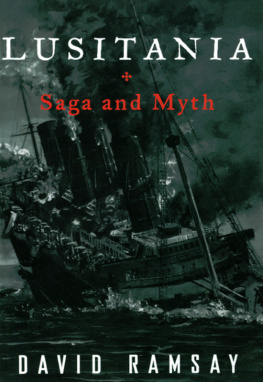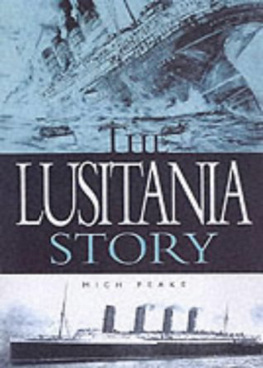A. A. Hoehling - The Last Voyage of the Lusitania
Here you can read online A. A. Hoehling - The Last Voyage of the Lusitania full text of the book (entire story) in english for free. Download pdf and epub, get meaning, cover and reviews about this ebook. year: 1996, publisher: Madison Books, genre: Detective and thriller. Description of the work, (preface) as well as reviews are available. Best literature library LitArk.com created for fans of good reading and offers a wide selection of genres:
Romance novel
Science fiction
Adventure
Detective
Science
History
Home and family
Prose
Art
Politics
Computer
Non-fiction
Religion
Business
Children
Humor
Choose a favorite category and find really read worthwhile books. Enjoy immersion in the world of imagination, feel the emotions of the characters or learn something new for yourself, make an fascinating discovery.

- Book:The Last Voyage of the Lusitania
- Author:
- Publisher:Madison Books
- Genre:
- Year:1996
- Rating:5 / 5
- Favourites:Add to favourites
- Your mark:
- 100
- 1
- 2
- 3
- 4
- 5
The Last Voyage of the Lusitania: summary, description and annotation
We offer to read an annotation, description, summary or preface (depends on what the author of the book "The Last Voyage of the Lusitania" wrote himself). If you haven't found the necessary information about the book — write in the comments, we will try to find it.
Chronicles one of the greatest sea tragedies of our time.
The Last Voyage of the Lusitania — read online for free the complete book (whole text) full work
Below is the text of the book, divided by pages. System saving the place of the last page read, allows you to conveniently read the book "The Last Voyage of the Lusitania" online for free, without having to search again every time where you left off. Put a bookmark, and you can go to the page where you finished reading at any time.
Font size:
Interval:
Bookmark:
The Last
Voyage of the
Lusitania
Voyage of the
Lusitania
A. A. Hoehling and Mary Hoehling

Copyright1956, 1996 by Adolph A. and Mary Hoehling
All rights reserved.
No part of this book may be reproduced in any form or by any electronic or mechanical means, including information storage and retrieval systems, without written permission from the publisher, except by a reviewer who may quote passages in a review.
Originally published in 1956 by Holt. Reprinted in 1991 by Bonanza books.
Published by Madison Books
4720 Boston Way
Lanham, Maryland 20706
3 Henrietta Street
London WC2E 8LU, England
The Library of Congress has cataloged the 1991 edition as follows:
Hoehling, A.A. (Adolph A.)
The last voyage of the Lusitania / A. A. Hoehling and Mary Hoehling.
p. cm.
Reprint. Originally published : New York: Holt, c1956
Includes bibliographical references and index.
ISBN 978-1-56833-078-5
1. Lusitania (Steamship) I. Hoehling, Mary Duprey
II. Title.
D592.L8H6 1991
940.4514dc20 | 9025109 |
CIP |
ISBN 1568330782 (pbk : alk. paper)
Distributed by National Book Network
 The paper used in this publication meets the minimum requirements of American National Standard for Information SciencesPermanence of Paper for Printed Library Materials, ANSI Z39.481984.
The paper used in this publication meets the minimum requirements of American National Standard for Information SciencesPermanence of Paper for Printed Library Materials, ANSI Z39.481984.
Manufactured in the United States of America.
To the Memory of
the Lost Members of the Gun Crew of
the SS James Harrod
in World War II
The dead have not lived and died in vain. They have brought us all a little nearer togetherwe think better of our kind...
Elbert Hubbard
NEW EDITION
The antique clock still ticktocks on the mantle of Theodate Pope Riddles mansion in Farmington, Connecticut, but the owner is not home. Along with her many fellow survivors of the Lusitania, Theodate was one of a gentle, trusting, and perhaps improbable generation who sailed through war-imperiled waters into history.
The old trolley no longer rattles from Taftville to New London, and the memory of a heroine in her time is fast diminishing. But Elizabeth Duckworth, in death, started the authors on their search for survivors of the ill-fated liner. We met her, in fact, in her coffin. This inspired us to seek out the living. We found them.
Dorothy Conner, a Red Cross volunteer from Oregon; big, rangy James Jay Brooks, a salesman from South Paris, Maine; Virginia Bruce Loney, the fourteen-year-old daughter of an expatriate American returning to England; Leslie Morton, an eighteen-year-old British seaman; Florence Padley of Vancouver, five months pregnant; twelve-year-old Avis Dolphin of Ontario, en route to England to live with her grandparents; the Reverend H. L. Gwyer, Episcopal minister from Calgary, Alberta; Lady Margaret Mackworth, one of Englands most militant suffragettes; Albert A. Bestic, a junior third officer of the Lusitania; Olive North, of England... and others. We cherished their all too brief friendship. One by one, their Christmas letters stopped. But as living memory faded, the Lusitania, like the Titanic, persisted as reality in peoples mindsincluding ours.
After World War II there was a resurgence of interest with the wreck itselfas if there were not enough sunken ships worldwide! The publication of this book apparently sparked the interest of one diver, the late John Light, who invited the authors to join in sponsoring an expedition. They declined. As it turned out, Light was concerned not so much with artifacts but with political issues, such as whether the Cunarder was armeda question bruited about ever since and even before the torpedoing. One passenger from New York was so intrigued that on the last voyage he prowled every foot of deck space, peering under winches and wherever there was any recess or overhang. Michael Byrne reported to the State Department (as on file in the National Archives), I took particular notice to see if they had any guns mounted or unmounted. There were none. I inspected every deck above the waterline.
As a naval auxiliary, the Lusitania was reinforced for mounting ponderous three- or six-inch guns. Either caliber, however, needed to be installed by dockside cranes, and neither could be effectively camouflaged, much less hidden. Unlike some other Cunardersher sister Mauretania, for examplethe Lusitania remained in passenger service after the outbreak of hostilities. She had never been fitted with any guns. In fact, successive salvage expeditions retrieved almost everything but guns: three of the liners four huge brass propellers, the two bow anchors, a ships bell, the raised brass lettering of Lusitania from her bow, silver and chinaware (by cutting a hole in the stern), and other objects. Some are on display in a small museum in Kinsale, Ireland.
Robert D. Ballard of the Woods Hole Oceanographic Institution and discoverer of the Titanic led the most scientific exploration of the Lusitania in 1993. His cameras found the wreck lying on its starboard side, badly crushed, cracked open amidships, and resembling a junkyard more than a luxury liner.
The strong currents and cloudy waters of the Celtic Sea made both exploration and photography difficult. Speculating on what most likely had compounded the torpedos damage and hastened the vessels sinking, Ballard observed,... a coal dust explosion. The German torpedo struck the liners starboard side about ten feet below the waterline, rupturing one of the long coal bunkers that stretch along both sides. He estimated that the bunker was nearly empty at the end of the voyage, with only inflammable dust remaining. This dust would be easily ignited by an exploding torpedo.
The respected oceanographer thereby effectively put to rest one of the several recurrent, specious rumors that has surrounded the tragedy: that she was carrying ammunition. The Lusitania was primarily a passenger liner, not a freighter, and her cargo space was extremely limited. One has but to look at a World War II photograph of an ammunition steamer hit by a torpedo or bomb to see the difference. It disappears in a towering mushroom cloud.
The myth of the guns and heavy ammunition, however, reached its ultimate idiocy in the cloak-and-dagger Churchill plot theory: Churchill, as First Sea Lord, wants to hurry the United States into the war. He surmises that the sinking of a great liner with the loss of American lives would surely arouse public opinion to bellicose heights. He knows, from previous torpedoings, that U-boats are active off the south coast of Ireland. He keeps this information from the approaching Lusitania and makes sure that the heaviest patrols are out of the area at the critical time.
The so-called plot theory was utter nonsense. Great Britain did not then need the United States as an ally. The latter was serving as a major supplier of assorted war materiel, from trucks and shells to uniforms and toothbrushes. The war was just a bit over nine months old, and Britain was not yet hurting as were France, Russia and Germany. The great wasting battles of Jutland, the Somme and Passchendaele, for but three, were yet to be fought.
Next pageFont size:
Interval:
Bookmark:
Similar books «The Last Voyage of the Lusitania»
Look at similar books to The Last Voyage of the Lusitania. We have selected literature similar in name and meaning in the hope of providing readers with more options to find new, interesting, not yet read works.
Discussion, reviews of the book The Last Voyage of the Lusitania and just readers' own opinions. Leave your comments, write what you think about the work, its meaning or the main characters. Specify what exactly you liked and what you didn't like, and why you think so.

